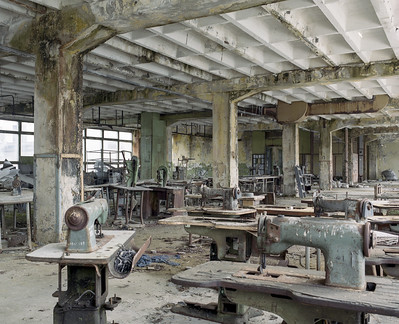Archive for the ‘Additive Manufacturing’ Category
If you want to make a difference, change the design.
 Why do factories have 50-ton cranes? Because the parts are heavy and the fully assembled product is heavier. Why is the Boeing assembly facility so large? Because 747s are large. Why does a refrigerator plant have a huge room to accumulate a massive number of refrigerators that fail final test? Because refrigerators are big, because volumes are large, and a high fraction fail final test. Why do factories look as they do? Because the design demands it.
Why do factories have 50-ton cranes? Because the parts are heavy and the fully assembled product is heavier. Why is the Boeing assembly facility so large? Because 747s are large. Why does a refrigerator plant have a huge room to accumulate a massive number of refrigerators that fail final test? Because refrigerators are big, because volumes are large, and a high fraction fail final test. Why do factories look as they do? Because the design demands it.
Why are parts machined? Because the materials, geometries, tolerances, volumes, and cost requirements demand it. Why are parts injection molded? Because the materials, geometries, tolerances, volumes, and cost requirements demand it. Why are parts 3D printed? For prototypes, because the design can tolerate the class of materials that can be printed and can withstand the stresses and temperature of the application for a short time, the geometries are printable, and the parts are needed quickly. For production parts, it’s because the functionality cannot be achieved with a lower-cost process, the geometries cannot be machined or molded, and the customer is willing to pay for the high cost of 3D printing. Why are parts made as they are? Because the design demands it.
Why are parts joined with fasteners? It’s because the engineering drawings define the holes in the parts where the fasteners will reside and the fasteners are called out on the Bills Of Material (BOM). The parts cannot be welded or glued because they’re designed to use fasteners. And the parts cannot be consolidated because they’re designed as separate parts. Why are parts held together with fasteners? Because the design demands it.
If you want to reduce the cost of the factory, change the design so it does not demand the use of 50-ton cranes. If you want to get by with a smaller factory, change the design so it can be built in a smaller factory. If you want to eliminate the need for a large space to store refrigerators that fail final test, change the design so they pass. Yes, these changes are significant. But so are the savings. Yes, a smaller airplane carries fewer people, but it can also better serve a different set of customer needs. And, yes, to radically reduce the weight of a product will require new materials and a new design approach. If you want to reduce the cost of your factory, change the design.
If you want to reduce the cost of the machined parts, change the geometry to reduce cycle time and change to a lower-cost material. Or, change the design to enable near-net forging with some finish machining. If you want to reduce the cost of the injection molded parts, change the geometry to reduce cycle time and change the design to use a lower-cost material. If you want to reduce the cost of the 3D printed parts, change the design to reduce the material content and change the design and use lower-cost material. (But I think it’s better to improve function to support a higher price.) If you want to reduce the cost of your parts, change the design to make possible the use of lower-cost processes and materials.
If you want to reduce the material cost of your product, change the design to eliminate parts with Design for Assembly (DFA). What is the cost of a part that is designed out of the product? Zero. Is it possible to wrongly assemble a part that was designed out? No. Can a part that’s designed out be lost or arrive late? No and no. What’s the inventory cost of a part that’s been designed out? Zero. If you design out the parts is your supply chain more complicated? No, it’s simpler. And for those parts that remain use Design for Manufacturing (DFM) to work with your suppliers to reduce the cost of making the parts and preserve your suppliers’ profit margins.
If you want to sell more, change the design so it works better and solves more problems for your customers. And if you want to make more money, change the design so it costs less to make.
Additive Manufacturing’s Holy Grail
 The holy grail of Additive Manufacturing (AM) is high volume manufacturing. And the reason is profit. Here’s the governing equation:
The holy grail of Additive Manufacturing (AM) is high volume manufacturing. And the reason is profit. Here’s the governing equation:
(Price – Cost) x Volume = Profit
The idea is to sell products for more than the cost to make them and sell a lot of them. It’s an intoxicatingly simple proposition. And as long as you look only at the volume – the number of products sold per year – life is good. Just sell more and profits increase. But for a couple reasons, it’s not that simple. First, volume is a result. Customers buy products only when those products deliver goodness at a reasonable price. And second, volume delivers profit only when the cost is less than the price. And there’s the rub with AM.
Here’s a rule – as volume increases, the cost of AM is increasingly higher than traditional manufacturing. This is doubly bad news for AM. Not only is AM more expensive, its profit disadvantage is particularly troubling at high volumes. Here’s another rule – if you’re looking to AM to reduce the cost of a part, look elsewhere. AM is not a bottom-feeder technology.
If you want to create profits with AM, use it to increase price. Use it to develop products that do more and sell for more. The magic of AM is that it can create novel shapes that cannot be made with traditional technologies. And these novel shapes can create products with increased function that demand a higher price. For example, AM can create parts with internal features like serpentine cooling channels with fine-scale turbulators to remove more heat and enable smaller products or products that weigh less. Lighter automobiles get better fuel mileage and customers will pay more. And parts that reduce automobile weight are more valuable. And real estate under the hood is at a premium, and a smaller part creates room for other parts (more function) or frees up design space for new styling, both of which demand a higher price.
Now, back to cost. There’s one exception to cost rule. AM can reduce total product cost if it is used to eliminate high cost parts or consolidate multiple parts into a single AM part. This is difficult to do, but it can be done. But it takes some non-trivial cost analysis to make the case. And, because the technology is relatively new, there’s some aversion to adopting AM. An AM conversion can require a lot of testing and a significant cost reduction to take the risk and make the change.
To win with AM, think more function AND consolidation. More (or new) function to support a higher price (and increase volume) and reduced cost to increase profit per part. Don’t do one or the other. Do both. That’s what GE did with its AM fuel nozzle in their new aircraft engines. They combined 20 parts into a single unit which weighed 25 percent less than a traditional nozzle and was more than five times as durable. And it reduced fuel consumption (more function, higher price).
AM is well-established in prototyping and becoming more established in low-volume manufacturing. The holy grail for AM – high volume manufacturing – will become a broad reality as engineers learn how to design products to take advantage of AM’s unique ability to make previously un-makeable shapes and learn to design for radical part consolidation.
More function AND radical part consolidation. Do both.
Image credit – Les Haines
The Additive Manufacturing Maturity Model
 Additive Manufacturing (AM) is technology/product space with ever-increasing performance and an ever-increasing collection of products. There are many different physical principles used to add material and there are a range of part sizes that can be made ranging from micrometers to tens of meters. And there is an ever-increasing collection of materials that can be deposited from water soluble plastics to exotic metals to specialty ceramics.
Additive Manufacturing (AM) is technology/product space with ever-increasing performance and an ever-increasing collection of products. There are many different physical principles used to add material and there are a range of part sizes that can be made ranging from micrometers to tens of meters. And there is an ever-increasing collection of materials that can be deposited from water soluble plastics to exotic metals to specialty ceramics.
But AM tools and technologies don’t deliver value on their own. In order to deliver value, companies must deploy AM to solve problems and implement solutions. But where to start? What to do next? And how do you know when you’ve arrived?
To help with your AM journey, below a maturity model for AM. There are eight categories, each with descriptions of increasing levels of maturity. To start, baseline your company in the eight categories and then, once positioned, look to the higher levels of maturity for suggestions on how to move forward.
For a more refined calibration, a formal on-site assessment is available as well as a facilitated process to create and deploy an AM build-out plan. For information on on-site assessment and AM deployment, send me a note at mike@shipulski.com.
Execution
- Specify AM machine – There a many types of AM machines. Learn to choose the right machine.
- Justify AM machine – Define the problem to be solved and the benefit of solving it.
- Budget for AM machine – Find a budget and create a line item.
- Pay for machine – Choose the supplier and payment method – buy it, rent to own, credit card.
- Install machine – Choose location, provide necessary inputs and connectivity
- Create shapes/add material – Choose the right CAD system for the job, make the parts.
- Create support/service systems – Administer the job queue, change the consumables, maintenance.
- Security – Create a system for CAD files and part files to move securely throughout the organization.
- Standardize – Once the first machines are installed, converge on a small set of standard machines.
- Teach/Train – Create training material for running AM machine and creating shapes.
Solution
- Copy/Replace – Download a shape from the web and make a copy or replace a broken part.
- Adapt/Improve – Add a new feature or function, change color, improve performance.
- Create/Learn – Create something new, show your team, show your customers.
- Sell Products/Services – Sell high volume AM-produced products for a profit. (Stretch goal.)
Volume
- Make one part – Make one part and be done with it.
- Make five parts – Make a small number of parts and learn support material is a challenge.
- Make fifty parts – Make more than a handful of parts. Filament runs out, machines clog and jam.
- Make parts with a complete manufacturing system – This topic deserves a post all its own.
Complexity
- Make a single piece – Make one part.
- Make a multi-part assembly – Make multiple parts and fasten them together.
- Make a building block assembly – Make blocks that join to form an assembly larger than the build area.
- Consolidate – Redesign an assembly to consolidate multiple parts into fewer.
- Simplify – Redesign the consolidated assembly to eliminate features and simplify it.
Material
- Plastic – Low temperature plastic, multicolor plastics, high performance plastics.
- Metal – Low melting temperature with low conductivity, higher melting temps, higher conductivity
- Ceramics – common materials with standard binders, crazy materials with crazy binders.
- Hybrid – multiple types of plastics in a single part, multiple metals in one part, custom metal alloy.
- Incompatible materials – Think oil and water.
Scale
- 50 mm – Not too large and not too small. Fits the build area of medium-sized machine.
- 500 mm – Larger than the build area of medium-sized machine.
- 5 m – Requires a large machine or joining multiple parts in a building block way.
- 0.5 mm – Tiny parts, tiny machines, superior motion control and material control.
Organizational Breadth
- Individuals – Early adopters operate in isolation.
- Teams – Teams of early adopters gang together and spread the word.
- Functions – Functional groups band together to advance their trade.
- Supply Chain – Suppliers and customers work together to solve joint problems.
- Business Units – Whole business units spread AM throughout the body of their work.
- Company – Whole company adopts AM and deploys it broadly.
Strategic Importance
- Novelty – Early adopters think it’s cool and learn what AM can do.
- Point Solution – AM solves an important problem.
- Speed – AM speeds up the work.
- Profitability – AM improves profitability.
- Initiative – AM becomes an initiative and benefits are broadly multiplied.
- Competitive Advantage – AM generates growth and delivers on Vital Business Objectives (VBOs).
Image credit – Cheryl
 Mike Shipulski
Mike Shipulski